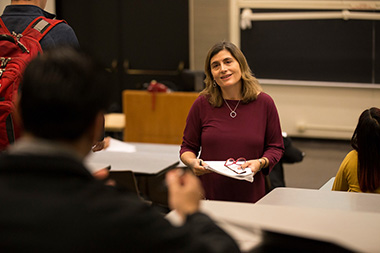Household Products and Fetal Development: Is There a Dangerous Link?
 |
|
Erin Bell, professor of environmental health sciences, led a team to study the impacts of commonly found chemicals on the growth and development of unborn babies. |
ALBANY, N.Y. (Dec. 13, 2018) – Research from a School of Public Health team found that a pregnant mother’s exposure to certain chemicals doesn’t negatively impact the development of the child – a conclusion reached by way of analyzing dried blood spots taken from newborns years prior.
Erin Bell, professor of environmental health sciences, explains that concern has grown among public health experts and the medical community that household products containing chemicals believed to disrupt the endocrine system could be harmful to a fetus if the mother was exposed. Complicating the issue of studying exposure to these chemicals in newborns is that many of the commonly used techniques involve drawing an additional blood sample from the baby separate from standard testing – a technically feasible, but undesirable method.
Bell convened a team to study the topic using an unconventional method – studying dried blood spots taken from newborns as part of standard testing right after birth. With parental permission, the team used samples from these spots for analyses. The study and peer-reviewed paper was part of the larger Upstate KIDS Study, which tracks the ongoing growth, motor and social development of more than 6,000 babies born to 5,000 mothers between 2008 and 2010 in the 57 counties of upstate New York.
From the Upstate Kids cohort, the team looked at the characteristics of 1,040 infants from twin sets and 2,071 “singleton” infants. They measured gestational age, birth weight, length, head circumference and leanness, while looking at the blood spots for exposure to bisphenol A (BPA, commonly found in plastic), perfluorooctanesulfonic acid (PFO, commonly found in stain repellents and Teflon cookware) and perfluorooctanoic acid (PFOA, also found in Teflon). From their analysis, they concluded that for “singleton” babies, exposure to these chemicals was not associated with potentially dangerous characteristics, such as low birth weight or abnormally small head circumference.
The only association observed was for BPA and gestational age and birthweight among twins, but Bell cautions that this is more likely to be a result of twins having a greater opportunity for exposure.
“Twin infants are often delivered prematurely and/or may have low birthweight, both factors that may warrant admission to the NICU. Given that these chemicals are often found in plastic, it is possible that exposure may occur after delivery for these infants,” said Bell. “Further testing needs to be done to confirm this potential explanation, but our results lead us to believe that it’s not actually the chemicals causing these birth results for twins, but rather the challenges that accompany twin pregnancies that may lead to increased potential for exposure.”
Perhaps even more important than the findings showing that these chemicals don’t negatively impact the babies in this study, said Bell, is that the team has confirmed that dried blood samples can be used for ongoing research even years down the line.
“This is preferable because as long as the parents provide consent to use these samples, it is an opportunity to measure chemical contaminants without drawing blood again. By saving newborn bloodspots, we’re opening up more opportunities for important public health research.”
![]() For more news, subscribe to UAlbany's RSS headline feeds
For more news, subscribe to UAlbany's RSS headline feeds
A comprehensive public research university, the University at Albany-SUNY offers more than 120 undergraduate majors and minors and 125 master's, doctoral and graduate certificate programs. UAlbany is a leader among all New York State colleges and universities in such diverse fields as atmospheric and environmental sciences, business, education, public health,health sciences, criminal justice, emergency preparedness, engineering and applied sciences, informatics, public administration, social welfare and sociology, taught by an extensive roster of faculty experts. It also offers expanded academic and research opportunities for students through an affiliation with Albany Law School. With a curriculum enhanced by 600 study-abroad opportunities, UAlbany launches great careers.


